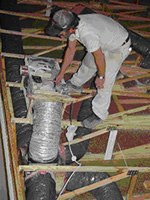
|
|
October 2006 |
Implementing Systems Engineering in HUD Code Manufactured Housing Factories Leads – Dave Chasar, Neil Moyer, David Beal (FSEC), Mike Lubliner
(WSU) and
At the request of HUD code home manufacturers, BAIHP researchers have conducted reviews and consulted on ways to make the homes’ systems work better together with six HUD Code home manufacturers. BAIHP consultation, recommendations, and training led to sweeping changes at four manufacturers’ factories that resulted in more than 106,000 energy-improved homes built in the past five and a half years. Changes included:
BAIHP worked with manufacturers to test the duct systems (and other performance indicators) in 101 houses representing 190 individually manufactured “sections.” The data was collected during 39 factory visits to 24 factories of six manufacturers between 1996 and 2003, and it showed robust correlation between duct leakage to the outside in completed houses (which can only be measured after the house is fully assembled) and total duct leakage (which can be measured in each section while it is on the production line) as well as evidence that substantially air-tight duct construction with mastic could be cost-effectively achieved in the HUD Code home manufacturing environment. Based on this data, the National Fire Protection Association’s (NFPA) approved a new standard on duct tightness, as well as a refined duct-testing protocol. Typically, standard NFPA-501 is ultimately incorporated into the HUD Code, which governs the construction of more than 250,000 HUD code homes each year. BAIHP work with HUD Code manufacturers also resulted in indoor air quality studies facilitated with LBNL and in many factories becoming ENERGY STAR-certified. BAIHP Factory Builder Partners include:
Resources: The complete research paper can be viewed at:
|
